
![]()
~ ORANGE STREET ~
Prince of Orange Street / Prince of Orange Lane
CANTERBURY
_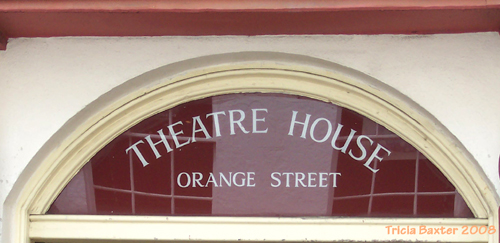
"In Prince of Orange Lane, now called Orange Street, is a third methodist meeting house, and nearly opposite, the theatre, erected in 1789, when the building over the butter market, before used for that purpose was taken down."
Sir Thomas More's House - In Orange Street are the remains of the house of Sir Thomas More. It was a spacious and noble building, built in the form of a quadrangle, having the entrance through a large gateway now standing on the south side of the street; in front of the house and between the two wings was a large court yard which is now called Dancing School Yard. The building is principally of wood, with gable front, and a long range of windows extending all along the front of the building, very much ornamented with stained glass, of which little remains. The rooms are spacious, and ornamented with carved mouldings or cornices. The walls were painted in fresco, as appears from the wall of the upper apartment, in which may be seen some very good designs. The whole building is now converted into a wool warehouse. 1838D
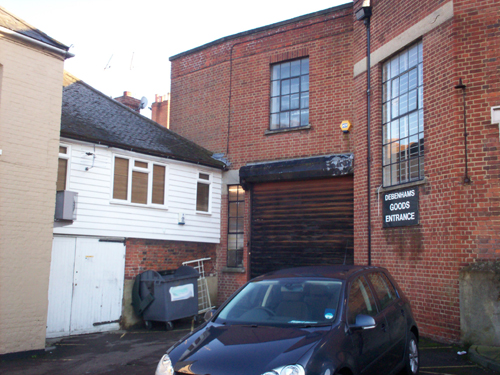
A view of the area where Dancing School Yard was, thanks to S.W. for the use of this photograph
"and the remains of the palace of Sir Thomas More, in the dancing-school yard in Orange street, are now used as a warehouse for wool.." 1811
".. Another is the Theatre, erected in 1790, when the building over the Butter-market, before used for that purpose, was taken down, adjoining an entrance leading into a small court, called the Dancing School yard; the buildings round which, now used as a wool warehouse, were formerly the mansion and residence of Sir Thomas More, lord chancellor of England, who was beheaded in the reign of king Henry VIII."
At the entrance of Palace Street (on the left of Orange Street) is a small court called Dancing School Yard, in which is the Theatre. The buildings around this court were formerly the mansion and residence of Sir Thomas More, Lord Chancellor of England, beheaded in the reign of Henry VIII., for denying the King's supremacy.
Sept 1843 - In clearing the foundations of the old building lately taken down in the Dancing School Yard, Canterbury, said to have been the residence of Lord Chancellor More, a curious discovery was made a few days ago. In a cellar under the counting-house belonging to Mr. Roberts, woolstapler, the earth having been removed to a depth of ten or twelve inches, a pavement of encaustic tiles, regularly and beautifully arranged, was brought to view. Some of the tiles bear the figure of a fleur-de-lis, others of a star, and some a representation of a man on horseback. The centre of the floor is composted of plain tiles much worn, having a border of ornamental tiles to the breadth of about 3 feet on each side. This floor is at a depth of 9 or 10 ft. below the present level of the exterior. The top of the stone arched window scarcely reaches to the outer surface. GM vol 174
"As late as the year 1842, there stood a very fine old timber house, in a yard or close called "Dancing School Yard," in the centre of the city of Canterbury, which was traditionally called Sir Thomas More's house. For many years it had been the warehouse of some wool staplers. The proprietor, a man of Ramsgate, and no true man of Kent, knocked it down in 1842. Whether it were Sir Thomas More's house or not, it was a quiant and curious and most interesting building, and it ought not to have been destroyed." Knight's Excursion Companion 1851
Accounts for building the meeting house (in dancing school yard, Orange street) 1696 *congregational church
In Orange-street are the remains of the house of Sir Thomas More. It was a spacious and noble building, built in the form of a quadrangle, having the entrance through a large gateway, now standing on the south side of the street; in front of the house, and between the two wings, was a large court-yard, which is now called Dancing School Yard. The building is principally of wood, with gable front, and a long range of windows extending all along the front of the building, very much ornamented with stained glass, of which little remains. The rooms are spacious, and ornamented with carved mouldings or cornices. The walls were painted in fresco, as appears from the wall of the upper apartment, in which maybe seen some very good designs. The whole building is now converted into a wool warehouse. 1838
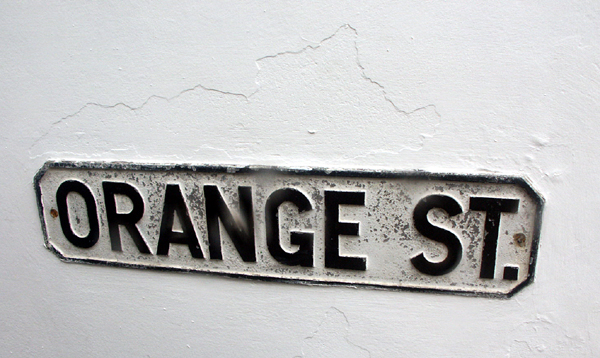
...and the remains of the palace of Sir Thomas More, in the dancing-school yard in Orange Street, are now used as a warehouse for wool; in other parts of the city the houses are in general handsome, and many of them modern and well built.
A Topographical Dictionary of England 1831
1830 Poll book
John REYNOLDS, Orange Street, Eating House
George GAMBIER, Senior, Orange Street, Builder
George GAMBIER*, Orange Street, Builder
Thomas ENGEHAM, Orange Street, Cordwainer
Robert BARRETT, Orange Street, Cordwainer
*Rivers, 10th Bart. (Eng.) Creat. 1621 - Sir James Francis RIVERS, 2nd son of the Rev. Sir Henry, the 9th bart., by the daughter of Samuel EALES, Esq., of Cranbury, Hants (now Dowager Lady Rivers). Born at Winchester 1822; mar. 1859 the eldest daughter of Mr. George GAMBIER, of Orange Street, Canterbury; succeeded his father in 1851; was formerly in the army. The 1st bart. was grandson of Sir John RIVERS, Knt., of Chafford, Kent, who was lord mayor of London temp. Elizabeth. Heir Pres. his bro. Cecil formerly in the 36th foot.
William John Burgess, formerly of Orange Street, Canterbury, grocer & cheesemonger. Then of no. 56 Tabernacle row, Finsbury, out of business or employment, then of Paul Street, Finsbury, then of No. 46 Bishopsgate street, then of.... The Law Advertiser 1823
Advertisement in the September 1768 Kentish Gazette, of Mrs. TERRY's Pastry Cook's Shop in Prince of Orange Lane

A picture of Orange street looking towards Palace Street, with the Seven Stars on the right

No. 1
"Under a statute of the reign of King Edward VI., only four innholders within the City could enjoy this privilege at the same time. Between 1660 and 1685 the following inns received a licence. The Crown in St. Mary Bredman, the Sun in St. Alphege, the Chequers in St. Andrews, the Red Lion (formerly the Lion at Hoop) in the High Street, where the licensee is described as a Surgeon; the Three Kings in All Saints, the White Heart in St. Margarets, the Seven Stars in St. Alphege, the Saracen's Head in All Saints and the Rose in St. Andrews"
1838 John Saffery HAYWARD, listed under Coach Builders, 1 Orange Street
1838 John Saffery HAYWARD, listed under Saddlers and Harness Makers, Orange Street
James JEFFERY, Watchmaker ^
Sarah THURSTON &
"SEVEN STARS" John MUNNS, Licensed Victualler *
1889 "SEVEN STARS HOTEL" John MUNNS
*Register Number 321 - United Kentish Briton's Friendly Society - Registered Office of the Society, Seven Stars Inn, Orange-street, Canterbury, established 1807, number of members 500, total assets, £7,715, total receipts (benefit fund) 1877 - £1,018
No. 2
1838 John REYNOLDS, listed under Eating House Keepers, 2 Orange Street
John REYNOLDS, Restaurant %
Richard BAKER, Cabinet Maker ^
1889 No. 2 & 3 H.T. JOHNSON, Carriage Manufacturer and Auctioneer
December 20, 1894 - H. T. JOHNSON, Coach Builder, 2 & 3 Orange Street. Special attention given to the painting and trimming departments, crests and heraldic devices accurately produced. The Show Room is well stocked with carriages of all descriptions. A visit is respectfully requested. Estimates Given. Repairs promptly executed.
Henry T. JOHNSON, Coach builder )

An ad from my collection, December 20, 1894
1903 Henry Thomas JOHNSON, Auctioneer & Coachmaker
July 16, 1904 - To be let, immediate possession, the commodious Business Premises, Nos. 2 and 3 Orange street, Canterbury, in its entirety or divided, if desired, comprising: a carriage factory, with two spacious showrooms, wheelwrights' shop, carpenters' shop, and paint shop, two forges, stabling for 10 horses, etc., good residence. For particulars, apply to Mr. Edwin L. GARDENER, Auctioneer and Valueer, 69 Castle Street, Canterbury.
No. 3
Sarah ELINGHAM, Milliner %
December 20, 1894 - H. T. JOHNSON, Coach Builder, 2 & 3 Orange Street
1889 No. 2 & 3 H.T. JOHNSON, Carriage Manufacturer and auctioneer
1891 Henry T. JOHNSON with wife ANNE, daughter Edith F. Johnson and grandson Henry A. Barnard
February 1896 - The death of Miss Edith Frances JOHNSON, daughter of Mr. H. T. JOHNSON, auctioneer and valuer of Orange Street, Canterbury, took place on the 22nd inst. It appeared that the deceased was out in the evening with a young man named George Henry WOOD, they afterwards proceeding to his lodgings, where supper was laid. WOOD left the room for a few moments leaving Miss Johnson alone. When he returned the landlady said, "Edie has fainted." WOOD noticed blood on the floor, and at once sent for Dr. JOHNSON. When the doctor arrived, the deceased appealed to him to save her life, and said she did it herself. From the evidence of Mr. J. H. Joyce, house surgeon at the Kent and Canterbury Hospital, it appeared that there was a punctured wound on the inner side of the front of the left thigh three inches below the groin, the cut going down to the bone and severing the muscles of a large branch of the femoral artery. It is supposed that (the) deceased stabbed herself while in a fit of jealousy. (Kent & Canterbury Press, Dec 26, 1896)
*George Henry WOOD, likely son of George Wood of Ashford Road, Thanington, Horse Dealer. He would have been 24 at the time (born Canterbury), he was noted as Horse dealers Assistant. The family was living in Gravel Walk in Canterbury in 1881, Gravel Walk 1901
Henry T. JOHNSON, Coach builder )
1903 Henry Thomas JOHNSON, Auctioneer & Coachmaker
July 16, 1904 - To be let, immediate possession, the commodious Business Premises, Nos. 2 and 3 Orange street, Canterbury, in its entirety or divided, if desired, comprising: a carriage factory, with two spacious showrooms, wheelwrights' shop, carpenters' shop, and paint shop, two forges, stabling for 10 horses, etc., good residence. For particulars, apply to Mr. Edwin L. GARDENER, Auctioneer and Valueer, 69 Castle Street, Canterbury.
 ___
___

No. 4
THEATRE HOUSE
1790. A large and elegant new theatre, erected at the sole expence of Mrs. Sarah Baker, in Prince of Orange Street, is opened this year for the performance of plays, &c. HT
1794 - Death, lately at Canterbury, Mrs. HANREE, wife of Mr. J. HANREE, baker in Orange Street KR
1794 - Dec - death, ...and in Orange Street, Mrs. Duryer, wife of Mr. James DURYER, turner
1801 Married at Canterbury, Mr. W. Smith, of Mrs. Baker's company of comedians, to Mrs. Cotesworth. TMM1801
The Canterbury Theatre is a handsome edifice, standing in Prince of Orange Street; it was first opened in the year 1790, having been built at the sole charge of Mrs. Sarah Baker. The Beauties of England and Wales 1808
Died at Rochester, Mrs. Baker, late proprietor of the Canterbury, Rochester, Maidstone, Tunbridge Wells and Faversham Theatres. NMM1816
"The Theatre situated in Orange street, is a neat building, of moderate dimensions, the windows of which are in the Egyptian style. The interior has a pleasing appearance. The season commences in the month of November, and concludes in February. Theatrical representations also take place during the race week. It was built by Mrs. Sarah Baker, and opened in 1790." 1847D
The theatre, a neat and commodious edifice, erected by Mrs. Sarah BAKER, was opened in 1790; opposite to it is a concert room belonging to the members of the Catch Club, but now used by the members of the Apollonian Club for their concerts every Friday evening; the original Catch Club is now held in the new concert room in Guildhall Street. 1811
"The Theatre, situated in Orange Street is a neat building, having for its principal entrance a portico in the Grecian Doric taste; the style of the windows is Egyptian, surmounted by ornamental tablets. The interior is of pleasing appearance. The season begins about the month of November, and concludes in February, under the management of Mr. John SLOMAN; independently of which, theatrical representations take place during the race week in August." 1838
THEATRE - This place of public amusement has lately undergone considerable alteration. It now forms a handsome building, and ranks among the many improvements which have recently adorned our ancient city. The front is compoed, and shews considerable taste. The principal entrance is a Grecian Doric Portico, above which is a niche, intended for the statue of Shakspeare. The windows are in the Egyptian style, with ornamented tablets above. The interior is considerably improved by a new ceiling and black cornice. In the centre is an emblematical painting of Aurora, or the morning breaking forth. The fronts of the boxes are of a green ground with medallions of Camaieus painted, relieved by gold mouldings. The stage boxes have brass trellis work, lined with red cloth. The proscenium is red, and has an extremely rich appearance. WG
At the entrance of Palace Street, on the left hand in Orange Street, is a small court, now called Dancing School-yard, wherein stands the Theatre: the buildings around this court were formerly the mansion and residence...
England's Topographer 1828 G.Virtue
1889 No. 4 & 5 Barnwell & Baker, Wholesale Grocers
---- )
1903 H.M. & Son Baker, wholesale grocers, provision merchants & government contractors
No. 5
John Saffry HAYWARD, Coach Builder *A John Hayward, Coach Builder, listed in the 1840 Pigot's directory (no address listed)
1880 Kelly's Directory of the Leather Trades - H. T. Johnson, Coach & Carriage Builders
1885 Kelly's Directory of the Leather Trades - Henry Thomas Johnson, listed under Carriage Builders
1889 No. 4 & 5 Barnwell & Baker, wholesale Grocers
Philip JAMES, Billposter )

Showing 4 to 6 Orange street and beyond (in the background you can see The Friars Theatre under construction)
No. 6
William LAMMING, Victualler %
Thomas ADAMS, Lodging House Keeper *
1882 Thomas ADAMS, Shopkeeper
Geroge F. MUMMERY, Gas Stoker )

No. 7
Jack HOLLOWAY, Leather Salesman, Edward G. Chapman assist, Leather Salesmans Asst ^
1889 G. THURSTON
Sarah THURSTON, Shirt Maker (
John W. BROWNE )
The Friars Cottages
Frances HAYCOCK )
Matilda HALL )
Best Lane

Orange Street on the left, Best Lane straight ahead, The Friars to the right
King Street
No. 8
William PACKERMAN, Carver, Gilder & Painter ^
Bakers Shop *
1889 F.J. HAGELL, Baker
Frederick J. HAGELL, Baker )
1903 Frederick Joseph HAGELL, Baker
No. 9
1838 George GAMBIER, Listed under Bricklayers, 9 Orange Street
1838 George GAMBIER, listed under Builders and Carpenters, 9 Orange Street
John HAYWARD, Coach Builder %
Sophia SHOOSMITH, Dressmaker ^
John SAXBY, Carriers Agent (Pickford) *
1889 John NUTTING, Green Grocer
Jane EASTON )
1903 Mrs. Jane EASTON, Shell Fish Dealer
No. 10
George Gambier, Large Builder % *Listed as a Builder & Carpenter on Orange Street in the 1840 Pigot's Directory and in the 1824 Pigot's directory under Bricklayer &c.
1858 - 1870's George GAMBIER, Master Builder and major employer
1889 Jesse Twynham
---- )
No. 11
1838 Mrs. HALSEY, day, Boys and Girls' (listed under Academies and Seminaries), 11 Orange Street
1838 Thomas William HALSEY, Listed under Carpenters, 11 Orange Street
1838 Thomas William HALSEY, Lay Clerk of the Cathedral, 11 Orange Street
1838 Thomas William HALSEY, listed under Cabinet-Makers and Upholsterers, 11 Orange Street
1889 J. Amos
Frederick W. COLEMAN )
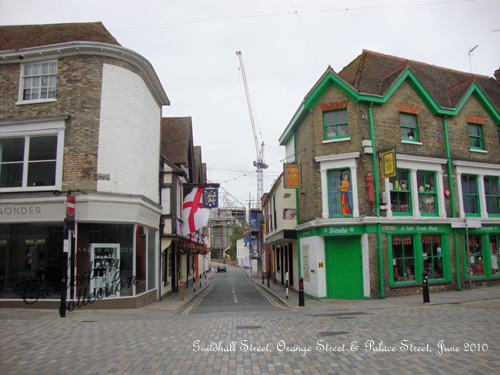
Orange street looking towards the Friars from No. 1 Palace Street (notice the Red Pump on the wall on the right)
No. 12
"PRINCE OF ORANGE"
July 1, 1825 - Small at the Prince Orange cut his throat....from the diary pages on the wall of the Westgate Museum
The Apollonian Catch club is of a similar character to the last (the Catch and Glee Club), and holds its meetings at the Prince of Orange, every Friday evening during the winter season. The admission is one shilling to non-subscribers: It is worthy of remark, that the combination of amateur musical talent exhibited at both these societies is rarely to be surpassed by any similar associations in the country.
1838 PRINCE OF ORANGE, James PAGE, 12 Orange Street
"Friendly Socities - The United Kentish Britons, held at the Prince of Orange, Orange street, was established 1807, for raising a fund to afford relief to its members in case of sickness or infirmity. The subscription of members is six shillings and sixpence per quarter, to be paid two shillings monthly, and sixpence extra every third month. During sickness a member receives fifteen shillings per week; 15l. is allowed for the burial of a member, and 5l. for a member's wife."
"The St. Alphage Amicable Society - Was instituted in 1832, and meets on the first Thursday in every month, for social and convivial enjoyment, alternately at the Prince of Orange, the Sun Inn, the Seven Stars, and the Prince of Wales. The members consist of those who pay rates to the parish of St. Alphage."
Thomas Young, Victualler ^
1889 Mrs. Eliza Sweetlove, Charwoman
No. 13
1838 Josh. STONE, Greengrocer only, 13 and 14 Orange Street
(Thomas LUDD, by a deed executed in 1649, bequeathed the sum of eleven shillings, the yearly quit rent of a house and premises situate in Orange Street, in the paris of St. Alphage, and occupied by Mr. Joseph STONE; ten shillings of which to be given to a minister for preaching a sermon, and one shilling to the parish clerk for officiating at the preaching of the said sermon, on the day of the election of a mayor for the city.)
Mary A. LADD, Lodging House Keeper % ?
Phillips Hendra, Iron Moulder ^
Orginski Rosenfeld, Professor of Magic ^
John Nutting, Greengrocer *
1889 William Perkins
No. 14
1838 Josh. STONE, Greengrocer only, 13 and 14 Orange Street
Gibbon Ladd ?__*Had the City of London Tavern on Stour Street in 1840
George LADD, Bookseller and Agent %
Caroline Strand, Dressmaker ^
George Ashby, Tailor ^
1880's Frederick Miles, Cabinet Maker
1889 Alfred Miles, Cabinet Maker
ODD FELLOWS HALL (across from The Theatre)

1838 George HOBDAY, listed under painters, plumbers and glaziers, 15 Orange Street
George HAIGH, Tailor %
Charlotte LAMING ^
Francis MILES, Carpenter ^
1880's John Pay, Steward at ODD FELLOWS HALL, wife Jane Pay Stewardess at Oddfellows Hall
1882 ODD FELLOWS HALL, John Pay, Manager
1889 ODD FELLOWS HALL M.U. resident manager, Chas. Measor - Military Lodge held at Oddfellow's Hall, every Tuesday evening: Secretary, Staff Armourer, A. Develin, The Barracks. The Manchester Unity Order of Oddfellows Friendly Society, Loyal City of Canterbury Lodge, No. 3,743. Meetings are held at the Odd Fellow's Hall, Orange Street, every Monday evening. Secretary, Bro. C.H. Read, 48 Havelock Street; Surgeon, Bro. J. Greasley, St. George's Place.
The Oddfellows' Hall - This building, the foundation-stone of which was laid by H. A. Munro-Butler-Johnstone, Esq., M.P. in July 17th, 1876, is situate in Orange Street, and was built from designs by Mr. J. E. Wiltshier, by the Canterbury Lodge (No. 3743) of the Manchester Unity Independent Order of Oddfellows, to form a club and institute for themselves, at a cost of £2,500. It is let for entertainments, meetings, lecturers, &c.
1913 - Frank Moys, Steward
1917 - Amalgamated Society of Carpenters and Joiners - Meets every alternate Saturday night at the Odd Fellows Hall
1917 - M.U.I.O.O.F. Lodge "City of Canterbury", No. 3743, held at the Odd Fellows Hall, Orange Street; about 1300 members; Secretary, Mr. A. JOAD; Surgeon, R. J. Ferguson, Esq. 10 St. George's Place
1917 - M.U.I.O.O.F. Juvenile Branch - in connection with Lodge 3743 - Held at the Odd Fellows Hall the 4th Monday in the month; 500 members; Secretary, Mr. H. MOYS, 81 Military Road; Surgeon, R. J. FERGUSON, Esq., 10 St. George's Place
1917 - M.U.I.O.O.F. Military Lodge, Established 1889 - held at the Odd Fellows Hall, Orange street on Wednesdsays; 200 members; Secretary, Mr. W. M. KING, 4 Guildford Road; Treasurer, Mr. A. HARDING, Havelock Street
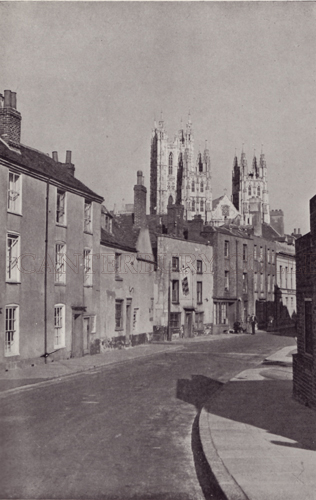
A view of Orange street with the Cathedral in the background
No. 16
1838 Thomas GODDEN, Listed under Boot & Shoe Maker, 16 Orange Street
William CASTLE, Butcher (b. Canterbury) wife Mary mother Mary Castle %
*Castle family also has some relation to the TERRY's
A Mary Ann Castle was born about 1817 in Canterbury, Kent. She married George Terry on December 25th, 1845, at Saint Dunstan, Stepney. George Terry was also born in Canterbury, Kent. (since the Terry's also lived on Orange street, this could possibly be the family they are related to).
John H. Clements, Shoe Maker ^
1877 Gibbs & Sons ?
Alfred Beken *
1889 Pickford & Co. General Carriers
1934 Canterbury Diocesan Notes (published monthly) and Canterbury Diocesan Directory (published annually in July), (Gibbs & Sons, publishers) 16 Orange Street, Canterbury
1958 Printing plate in my collection - Gibbs & Sons, printers and publishers 16 Orange Street, Canterbury Phone 2107
No. 17
1838 Mrs. Charlotte MARSH, listed under Corn Factors and Dealers (dealer), 17 Orange Street
1838 Mrs. Charlotte MARSH, listed under Mealmen, Orange Street
Charlotte MARSH, Baker (her son Thomas is also a Baker) %___*She is listed as a Baker in the 1840 Pigot's Directory in Orange Street
1858 Thomas MARSH, Baker and Corn Dealer (son of Charlotte Marsh above)
*Thomas Marsh - Received 13l from Mr. Bligh through Gogger, bribed two voters with 9l and kept 4l himself for a debt due at the election of 1847, Marsh, 12211. About 2l or 2l 10s. was due to witness, ib. 12223
1858 - 1860's Thomas MARSH, Master Baker & Corn Dealer
Charles T. Hutchinson *
1889 Mrs. Admans
No. 18
Frederick R. Holloway *
1907 - July 20th, For reliable Cycle Repairs go to Harden, 18 Orange Street, Canterbury
No. 19, 20, 21, 22
Frederick R. Holloway *
1889 Mummery Bros., Leather Merchants
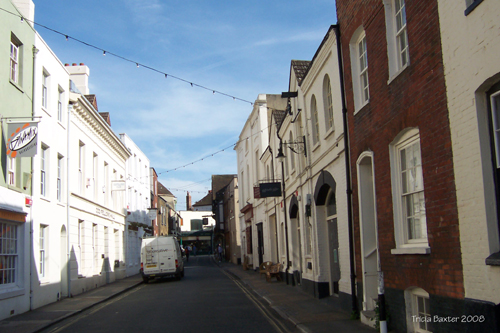
Orange Street Looking towards Palace Street
Palace Street
1805-7
BURGESS and WILMSHURST, coach makers
William PITTOCK, taylor